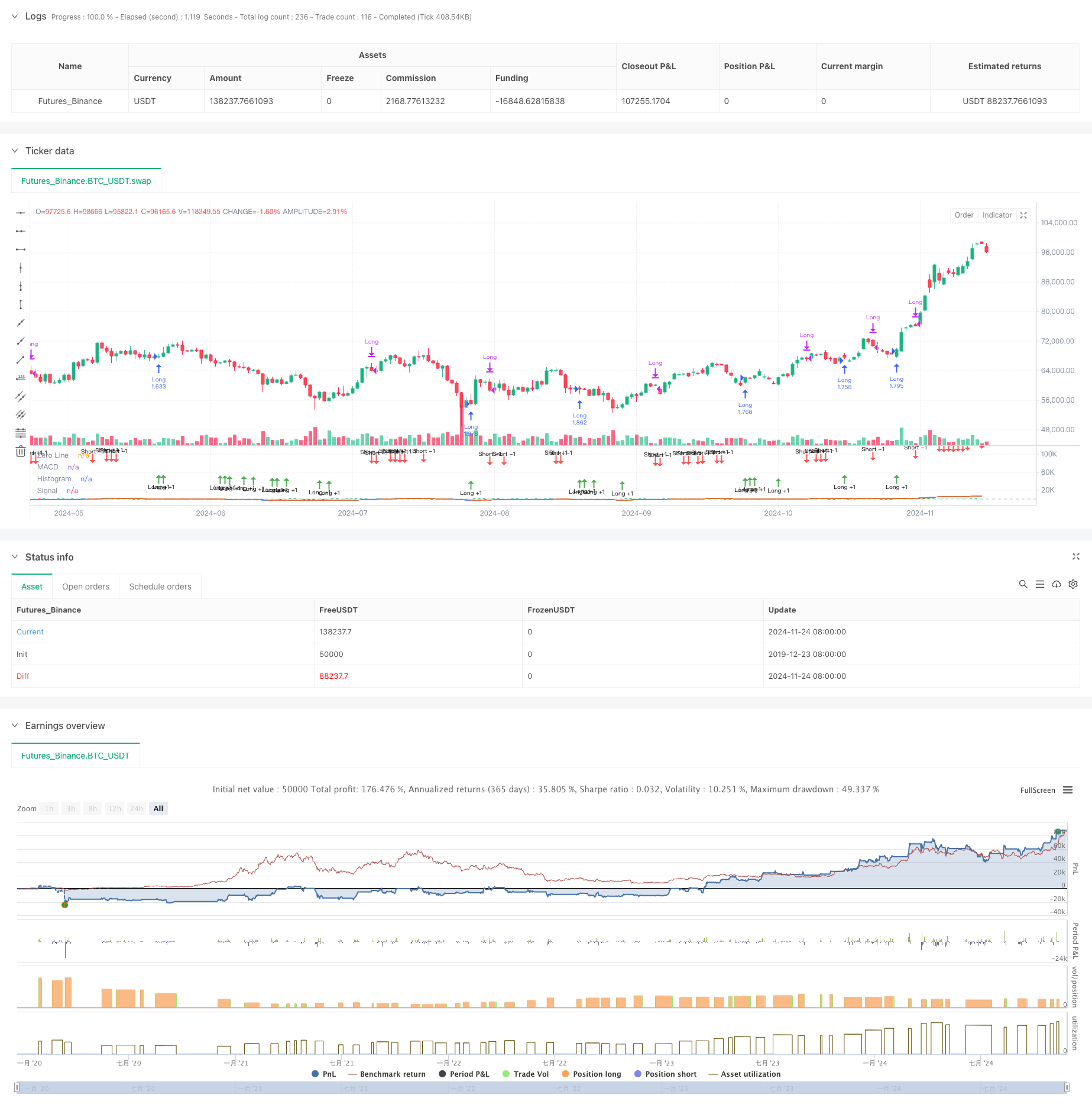MACD ダイナミック・オシレーション・クロスプレジクション戦略
作者: リン・ハーンチャオチャン,日付: 2024年11月27日 14:54:02タグ:マックドエイマSMAROC

概要
この戦略は,MACD (移動平均収束差異) 指標のダイナミックな特徴に基づいた取引決定をベースにしている.コアアプローチは,潜在的な金と死亡のクロスを予測するためにMACDヒストグラムの変化を観察することに重点を置く.この戦略は,よりよいエントリータイミングを得るためにヒストグラムのダイナミックな特徴を強調することによって,伝統的なMACDクロスオーバー信号を超えて行なわれる.
戦略の原則
この戦略は,迅速な (EMA12) と遅い (EMA26) 移動平均の違いを組み込む修正されたMACD指標システムを採用し,2期間の信号線を併用しています.コア取引論理はいくつかの重要なポイントに基づいています:
- トレンド動態を判断するためにヒストグラムの変化率 (hist_change) を計算する
- ヒストグラムがマイナスで,連続3期間の上昇傾向を示すとき,ロングポジションを入力することで,黄金十字信号を予測する
- ヒストグラムが陽性で,連続して3つの期間にわたって減少傾向を示すとき,ポジションを閉じることで,デッドクロス信号を予測する.
- 特定の時間帯内で取引する時間フィルタリングメカニズムの実施
戦略 の 利点
- 強力な信号予測: ヒストグラムの動態を観察して潜在的なクロスオーバー信号を予測し,エントリータイミングを改善する
- 合理的なリスク管理: 0.1%の手数料と3ポイントのスライプを含み,現実的な取引条件を反映する
- 柔軟な資本管理: 効果的なリスク管理のために,口座資本に対する割合に基づくポジションサイズを使用する.
- 優れた可視化: 貿易信号の色コードヒストグラムと矢印マークを使用し,分析を容易にする
戦略リスク
- 誤ったブレイクリスク: 変動市場では誤った信号が頻繁に発生する可能性があります.
- 遅延リスク:予測メカニズムにもかかわらず,MACDは固有の遅延を維持している.
- 市場環境依存: 戦略はトレンド市場でよりうまく機能し,変動条件では潜在的に劣る
- パラメータ感度: 戦略のパフォーマンスは,高速と遅いライン期間設定に大きく依存しています.
オプティマイゼーションの方向性
- 市場環境フィルタリング: 市場状況に基づいて取引パラメータを調整するために傾向識別指標を追加する
- 位置管理の強化:信号強度に基づいて動的位置サイズを導入する
- ストップ・ロスの実施: 引き上げを制御するために,遅延または固定ストップ・ロスを追加する.
- 信号確認の強化:クロスバリダーションのための追加の技術指標を組み込む
- パラメータ最適化: 市場状況に基づいて調整する適応性パラメータを実装する
概要
この戦略は,従来のMACD取引システムより改善するためにMACDヒストグラムのダイナミック特性を革新的に利用している.予測メカニズムは早期入場信号を提供し,厳格な取引条件とリスク管理措置は戦略の安定性を保証している.さらなる最適化と精錬により,この戦略は実際の取引条件で改善されたパフォーマンスを期待している.
/*backtest
start: 2019-12-23 08:00:00
end: 2024-11-25 08:00:00
period: 1d
basePeriod: 1d
exchanges: [{"eid":"Futures_Binance","currency":"BTC_USDT"}]
*/
//@version=5
strategy(title="Demo GPT - Moving Average Convergence Divergence", shorttitle="MACD", commission_type=strategy.commission.percent, commission_value=0.1, slippage=3, default_qty_type=strategy.percent_of_equity, default_qty_value=100)
// Getting inputs
fast_length = input(title="Fast Length", defval=12)
slow_length = input(title="Slow Length", defval=26)
src = input(title="Source", defval=close)
signal_length = input.int(title="Signal Smoothing", minval=1, maxval=50, defval=2) // Set smoothing line to 2
sma_source = input.string(title="Oscillator MA Type", defval="EMA", options=["SMA", "EMA"])
sma_signal = input.string(title="Signal Line MA Type", defval="EMA", options=["SMA", "EMA"])
// Date inputs
start_date = input(title="Start Date", defval=timestamp("2018-01-01T00:00:00"))
end_date = input(title="End Date", defval=timestamp("2069-12-31T23:59:59"))
// Calculating
fast_ma = sma_source == "SMA" ? ta.sma(src, fast_length) : ta.ema(src, fast_length)
slow_ma = sma_source == "SMA" ? ta.sma(src, slow_length) : ta.ema(src, slow_length)
macd = fast_ma - slow_ma
signal = sma_signal == "SMA" ? ta.sma(macd, signal_length) : ta.ema(macd, signal_length)
hist = macd - signal
// Strategy logic
isInDateRange = true
// Calculate the rate of change of the histogram
hist_change = hist - hist[1]
// Anticipate a bullish crossover: histogram is negative, increasing, and approaching zero
anticipate_long = isInDateRange and hist < 0 and hist_change > 0 and hist > hist[1] and hist > hist[2]
// Anticipate an exit (bearish crossover): histogram is positive, decreasing, and approaching zero
anticipate_exit = isInDateRange and hist > 0 and hist_change < 0 and hist < hist[1] and hist < hist[2]
if anticipate_long
strategy.entry("Long", strategy.long)
if anticipate_exit
strategy.close("Long")
// Plotting
hline(0, "Zero Line", color=color.new(#787B86, 50))
plot(hist, title="Histogram", style=plot.style_columns, color=(hist >= 0 ? (hist > hist[1] ? #26A69A : #B2DFDB) : (hist < hist[1] ? #FF5252 : #FFCDD2)))
plot(macd, title="MACD", color=#2962FF)
plot(signal, title="Signal", color=#FF6D00)
// Plotting arrows when anticipating the crossover
plotshape(anticipate_long, title="Long +1", location=location.belowbar, color=color.green, style=shape.arrowup, size=size.tiny, text="Long +1")
plotshape(anticipate_exit, title="Short -1", location=location.abovebar, color=color.red, style=shape.arrowdown, size=size.tiny, text="Short -1")
関連性
- Kの逆転指標 I
- CM MACD カスタム インディケーター - 複数のタイムフレーム - V2
- 2つのMACDトレンド確認取引システム
- ZeroLag MACD ロングショート戦略
- ゼロラグ MACD ダブルクロスオーバー取引戦略 - 短期トレンドキャプチャに基づく高周波取引
- 移動平均クロスオーバー+MACDスローラインモメント戦略
- MACD 多インターバルダイナミックストップ・ロスト・アンド・テイク・プロフィート・トレーディング・システム
- 最適化されたロング取引のためのMACDとマルティンゲール組み合わせ戦略
- 2つの移動平均MACDクロスオーバー日付調整可能な定量取引戦略
- MACD BB ブレイクストラテジー
もっと
- トリプル・ムービング・メアディア トレンドフォローとモメント・インテグレーション 定量取引戦略
- Zスコアとスーパートレンドベースのダイナミック・トレーディング戦略: ロング・ショート・スイッチングシステム
- アダプティブ・ボリンジャー・ブレイクと移動平均量的な戦略システム
- 複数の技術指標の統合を備えたAI最適化された適応型ストップ損失取引システム
- 多期移動平均のクロスオーバーと量分析システム
- 二重移動平均勢力の追跡量的な戦略
- 調整可能なストップ・ロストとテイク・プロフィートを持つ二重移動平均クロスオーバー戦略
- 動向オシレーターに基づく戦略をフォローする適応傾向
- PVT-EMA トレンド・クロスオーバー・ボリューム・価格戦略
- MACD-EMA 多期動的クロスオーバー量的な取引システム
- VWAP-ATR ダイナミック・プライス・アクション・トレーディング・システム
- Bollinger Bands と RSI クロス ベース ダイナミック トレンド 定量 戦略
- Bollinger Bands,RSI,ATRベースのダイナミックストップ・ロース・システムによる平均逆転戦略
- パラボリックSAR指標に基づくダイナミック取引戦略システム
- アダプティブ・ボラティリティ・アンド・モメント・量子トレード・システム (AVMQTS)
- Bollinger Bands と Candlestick パターンに基づく高度なトレンド取引戦略
- 脱出戦略の後にATR波動性と移動平均に基づく適応傾向
- 全体キャンドルシグナルシステムとダブルEMAモメンタムトレンド・トレード戦略
- RSI最適化システムとダブルタイムフレームスーパートレンド
- ダイナミックストップ・ロストとテイク・プロフィートシステムによる戦略をフォローする二重移動平均クロスオーバートレンド